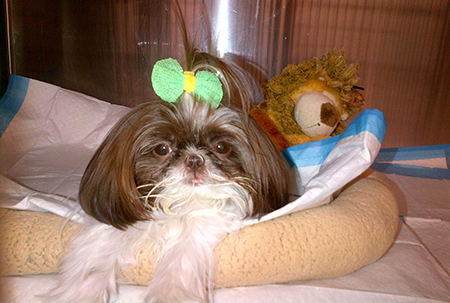Kidney Disease in Dogs and Cats
Kidney Disease in Dogs and Cats
 There are multiple types of kidney disease, but all types have the same end point: the kidneys’ ability to control water balance, filter waste products from the blood and keep minerals like sodium, potassium and chloride at optimal levels is compromised. Kidneys are even responsible for maintaining red blood cell production. With all these important roles, the kidneys are important organs and the veterinarians at AMC frequently treat pets with kidney problems. Here are the stories of three of them.
There are multiple types of kidney disease, but all types have the same end point: the kidneys’ ability to control water balance, filter waste products from the blood and keep minerals like sodium, potassium and chloride at optimal levels is compromised. Kidneys are even responsible for maintaining red blood cell production. With all these important roles, the kidneys are important organs and the veterinarians at AMC frequently treat pets with kidney problems. Here are the stories of three of them.
Congenital Kidney Disorder
Lulu is a minute shih tzu, tipping the scale lightly at 5 pounds. She is the brown and white dog seen in the photo. A vomiting episode when she was just a few months old prompted blood tests which identified elevations in her kidney blood tests. Because she is a shih tzu, the most common breed diagnosed with a developmental defect of the kidneys, congenital renal dysplasia, her kidneys were biopsied when she was spayed. A biopsy is the only method of confirming the diagnosis of congenital renal dysplasia. Over time, congenital kidney disease typically progresses, so to keep Lulu’s kidneys working as well as possible, she eats a kidney-friendly food with reduced protein content. Lulu celebrated her fourth birthday in June.
Acute Kidney Injury: Lilies and Lepto
Acute kidney injury (AKI), also called acute renal failure, is a serious condition that develops suddenly, often lasts a short time and may disappear completely once the underlying cause has been treated. AKI can also have long-lasting consequences with life-long problems. Two common causes of acute kidney injury seen at AMC are lily ingestion and leptospirosis.
Sam, a ginger striped cat, helped himself to a “lily salad” from the bouquet on the dining room table. When large pieces of lily leaves were noticed in the vomit, his concerned family contacted animal poison control. Animal poison control recommended a visit to the ER and hospitalization, so Sam came to AMC. The AMC veterinarians treated Sam’s dehydration and monitored his kidney blood tests closely. After four days of intravenous fluids, he was discharged to his anxious family with normal kidney blood tests.
Sam was a lucky cat; he recovered after ingesting the lilies. Research conducted at AMC shows only about half of pets diagnosed with AKI serious enough to require hemodialysis recover.
Feline Chronic Kidney Disease
Many of my readers already know Toby from his tangle with a hairball. During a routine recheck, blood tests revealed a slight increase in his kidney blood tests. Evaluation of a urine sample showed a lack of concentration typical of feline chronic kidney disease.
Unlike AKI, chronic kidney disease (CKD) doesn’t disappear with treatment and tends to worsen over time. To help manage Toby’s disease, he now eats a kidney-friendly diet specially made for cats and has his blood pressure monitored since cats with kidney disease often have hypertension.
Take good care of your pet’s kidneys, they only have two!
- Routine testing as part of an annual physical examination will help identify early kidney disease and promote implementation of treatments.
- Take a urine sample from your pet to their annual physical examination. Analysis of the sample helps to give a more complete picture of kidneys function.
- Prevent acute kidney injury by vaccinating your dog for leptospirosis, keeping your cat away from toxic lilies, and learning about other kidney toxins to avoid.


































